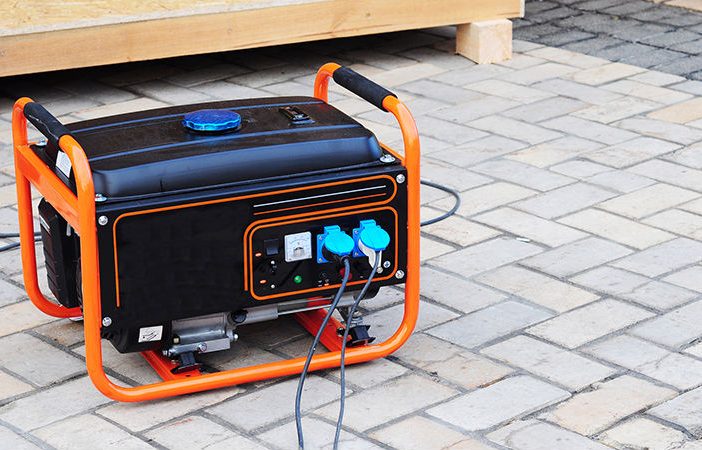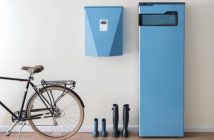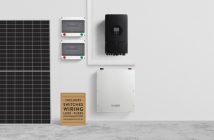South Africa faces its own unique challenges when it comes to power usage, therefore making buying a generator a common and often necessary decision. But, if you’re concerned about where to start with your generator-purchasing journey, we’re here to break down everything you need to know in order to make an educated decision.
Firstly, generators are now available in a wide range of sizes. Generators with power supply capacities of 5kW to 50kW are readily available in the personal and home use markets, while industrial generators are anywhere from 50kW to over 3 Megawatts.
A genset is either petrol or diesel driven, and is mechanically connected to an electrical generator. The engines need to be started either using a rope attached to the engine similar to that of a lawnmower or with a starter motor and a switch.
The generator part of the genset will start generating power once the engine starts and will stabilise at around 220 volts until a load or wattage is connected. This is where it is vitally important to decide what load is to be connected to the genset.
Unfortunately, generator under-sizing is one of the most common mistakes committed by buyers. Not only could it damage your generator, but it can also damage other assets connected to it, create hazardous situations, and even limit overall productivity of the unit and/or the business relying on it. If nothing else, the key thing to remember here is that more is always better than less.
Things to consider when buying a generator:
- Safety: Getting a certified electrician to install your generator is best, as generators need to be correctly installed and/or connected to the building via a suitable and approved change-over switch and an over current protection circuit breaker.
- Total electrical load to be connected.
- Voltage, frequency and phase.
- Does the generator need to start automatically? If so, then an automatic mains failure (AMF) mechanism needs to be installed. If not, a procedure needs to be put in place for manual start and switch over.
- Suitable location for the generator – outside or in vented area (not to be installed in an enclosed area or indoors).
- Acceptable noise levels.
- Altitude and running time.
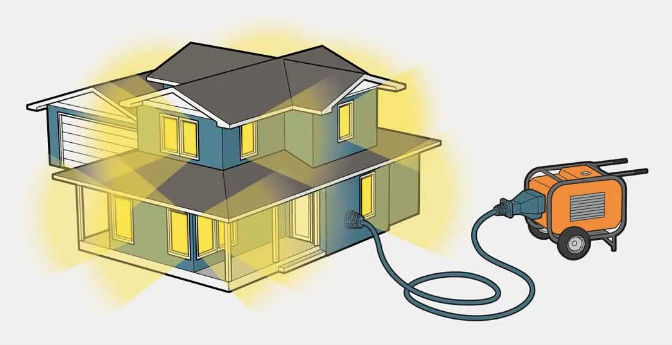
1. How big a generator should you get?
This capacity depends on the sum (maximum total load expected at any given time) of the electrical loads you want to power simultaneously, measured in watts. First, add up all the loads you know you want to be able to run simultaneously. Then, as a precaution, figure out which electrical item in your house requires the most electricity to start its motor and add that to your total, bearing in mind that the startup current of a pool pump motor, for example, is about 1.4 times the running load and large items like air conditioners, and some refrigerators can be two or three times what they use while running. Make sure your generator can accommodate that extra electricity needed so that larger items won’t overload the system if they start up.
Every generator has two wattage ratings: running wattage and surge wattage. Generators are rated for surge wattage because they should have some excess capacity in case the load you need is temporarily larger than what you’ve calculated. When you buy a generator, choose the size based on the running wattage and its surge wattage should automatically fall into line with what you need. If you’re worried about needing more surge wattage, buy a larger generator.
2. What loads should you consider powering with the generator?
- Kitchen, bathroom and sitting room lights.
- One plug in the kitchen for kettle or cellphone charger.
- Refrigerator/freezer
- Television and decoder.
- Garage door-opener
- Microwave/oven
- Computer
- Security – alarm systems/electric fencing/lighting
3. How do you calculate all this?
All heating appliances such as stoves, heaters, dishwashers, geysers, kettles, tumble dryers, toasters and hairdryers draw the most power. Controlling the number of lights switched on during generated power is advisable. PCs and electronic equipment don’t use much power but are voltage sensitive. If the generator does not deliver a constant voltage and there are dips and spikes in the system, equipment is likely to suffer damage. During generator use it is best to switch off some appliances when using others.

In this example you need a generator with the following capabilities: Recommended wattage: 3 692 (Appliance with the highest starting wattage + total running wattage for all other appliances = total wattage needed) Maximum wattage: 4700 Voltage: 220-240V.
Best 220-240V generator: Ryobi 5500W Petrol Key Start Generator

4. Do you need to hire an electrician to set up a generator safely?
A licensed electrician, who must carry out the installation, must understand and must have experience in wiring the switches, since incorrect wiring of all the live, neutral and earth wires could be life threatening.
You can check whether the electrician is registered by contacting the local offices of the Electrical Contracting Board of South Africa. In addition always make sure that he gives you a valid electrical certificate of compliance. never attempt this work yourself and never plug a supply from a genset into a socket of your house. If you do not want to install a changeover switch, a temporary extension lead from the genset can be used to plug in the equipment that you require.The lead size is important to ensure that it can carry the required load.
The transfer or change-over switch is likely to be a manual device which has three switching positions – most have a central off position and a position to the left and right of the off position. One is for the main supply and the other for the generator supply.
This will mean that when the main supply fails, the switch will have to be manually turned from mains to the generator supply. The whole process will have to be repeated once the main supply returns.
This “switching” procedure is a vital part of the process as a “back feed” is both potentially dangerous and can also damage the generator and electronic devices such as computers, TV and hi-fi. The main supply and the generator supply must never run in parallel. These transfer switches can also be automatically controlled, but this is far more complicated and costs a great deal more.
5. Can’t I just plug my generator into a wall outlet?
No. This is known as backfeeding, and it’s very dangerous for a variety of reasons. For instance, if someone forgets to throw the main circuit breaker to electrically isolate the house from the grid, then the generator could send electrical power beyond the house and out onto the grid. Also should the earth leakage or main switch be left on, when grid power resumes it will destroy your generator and could even cause electrical or other fires and many other hazards. In addition, if you choose to switch off the earth leakage main switch to avoid this issue, you need to remember that your family is at high risk of electrocution as when back-feeding power to your house, since the electrical system will not have earth leakage protection.
6. What’s the difference between a standby generator and a backup generator?
A standby generator is permanently installed apparatus, much like a compressor for a central air-conditioning system. Its engine runs on natural gas or propane. A backup generator is a small, petrol-engine generator that you wheel into position outside the house and then plug into the transfer switch. Or it can be connected to electrical loads via heavy-duty extension cords.
7. If it’s raining outside, can you put the generator in the garage and run it there, as long as the door stays open?
No. Never run a generator inside a house, inside a garage, under a carport, on a porch, inside a screened porch or near an open window. Even with the garage door open, the carbon monoxide (CO) in the generator’s exhaust can sicken somebody inside the house or, in the worst case, even kill someone.
8. What other safety tips should you keep in mind?
Have working smoke and CO detectors in the house when using a generator. Keep the generator at least 5 metres from the house to minimise risks from CO and also the risk of the generator’s hot muffler melting vinyl siding. Never fuel a generator while it is operating (running) or when it’s hot as it is a huge fire/explosion hazard. Remember: “Let it cool before you fuel.”
9. Generators are loud.
What can be done about that? Unfortunately, not much. More mechanically advanced generators do a better job than older ones at adjusting engine rpm to their electrical output. This reduces their running speed, which is quieter and conserves fuel. The simplest way to reduce generator noise is to reduce the electrical load you’re imposing on it.
10. Does the generator need to be grounded?
Follow the instructions in the owner’s manual. If the manual calls for grounding the generator, that’s relatively easy to do. One simple way is to run a 12-gauge ground wire from the grounding terminal on the generator to a copper ground rod you’ve driven into the soil next to the generator. (The generator will have a grounding terminal symbol to help you identify the terminal’s location.)
As an alternative, the manual may ask you to run a ground wire from the generator’s grounding terminal to the ground bus inside the house’s service panel. As long as you follow the instructions provided in the manual, the generator will be safely grounded.
Typical sizes needed:
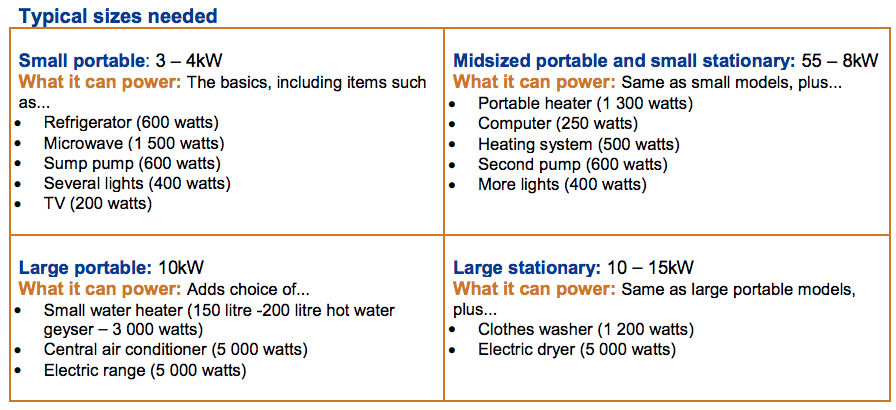
Still looking for the perfect generator? Check out PriceCheck’s listings and deals of power-providing solutions!

